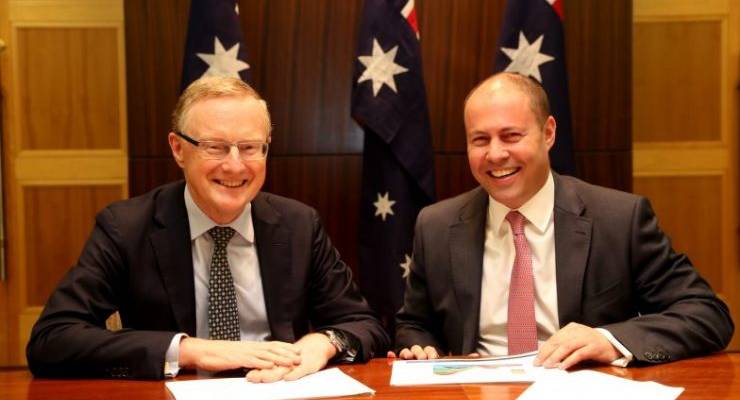
Why did Treasurer Josh Frydenberg feel the need to co-opt the Reserve Bank governor Philip Lowe last Thursday for a photo-op to spruik the strength of the economy? Even the Financial Review wondered about it, suggesting that given both men thought the economy was so good, the RBA shouldn’t have just cut interest rates twice.
Contra that AFR editorial, it’s not just “progressive commentators” who have suggested that the economy is in poor shape — unless you count the Productivity Commission amongst progressives. Or the ABS, which every quarter brings forth yet more evidence of the extent of wage stagnation. Or Lowe himself, who devoted much of a speech immediately after the election to detailing the worrying slowdown in household income growth and its damaging impact on spending.
That makes Thursday’s little photo-op, and Lowe’s statement “I agree 100% with you that the Australian economy is growing and the fundamentals are strong,” all the more peculiar. As Michael Pascoe noted, “Lowe suddenly had to pretend all was tickety-boo – implying that he’d been terribly mistaken this month, last month, the month before, pretty much all his senior career at the bank.”
The media event followed a meeting between Frydenberg and Lowe to have what the Treasurer called “a very productive discussion with senior Treasury officials about the global and domestic economic outlook.” Except, Frydenberg doesn’t need to meet with Lowe for that. There’s a senior Treasury official who attends every RBA board meeting — Frydenberg’s own Treasury Secretary, Phil Gaetjens. He represents the government on the RBA board for each month’s monetary policy meeting.
While he holds that position ex officio, he is expected to contribute. His predecessor, John Fraser, was an indifferent participant with some attendees at times wondering if he actually wanted to be there. Gaetjens, however, is seen as a diligent board member, reading the monthly briefing documents sent out at the end of the week before each meeting.
Given Gaetjens’ attendance at the two most recent meetings when the RBA board decided to cut the cash rates to successive record lows, why did Frydenberg find it necessary to summon Lowe to discuss the economy? What could Lowe have told him that Gaetjens couldn’t, given Gaetjens was in the room and contributing to the recent decisions by the Bank?
Well, of course, Frydenberg couldn’t have a photo op with Gaetjens. Or if he did, it wouldn’t have carried any weight. Gaetjens is a political appointee, and is assumed to simply be running Treasury as the biggest ministerial office in the world, rather than an independent department. It is now the Reserve Bank that runs economic debate in Australia, with help from another independent entity, the Productivity Commission. Treasury has been sidelined (in a similar way, the Parliamentary Budget Office is now the independent authority on budget numbers, not Treasury).
So with the economy flagging and pressure from Lowe, and many commentators, for the government to be doing more on both infrastructure spending and economic reform, it seems Frydenberg needed some credibility and substance behind him while trying to convince us all everything is OK.
Back during the financial crisis in 2008 and 2009, Kevin Rudd used to do the same thing with Gaetjens’ predecessor Ken Henry, relying heavily on Henry’s authority as a kind of human shield for the government’s massive stimulus packages. It led to Coalition criticism of Henry that he was allowing himself to be used for political purposes by Rudd.
But Henry, like Gaetjens, was a public servant at the beck and call of ministers. Lowe is supposed to be independent, and not a source of artificial economic credibility to be summoned at the price of mixed signals from the central bank.
Was the photo-op a good move for the RBA boss? Write to boss@crikey.com.au and let us know your thoughts.









Michael Pascoe used the word “excruciating” to describe Lowe’s appearance and statement at the photo-op with Frydenberg. It certainly was. And Pascoe’s article was excoriating.
On that photo op.
What a pic. Three Aussie flags behind the beaming duo and a star gracing both their heads. Still, it doesn’t convince me that the economy is ticketyboo. So disappointing that Josh hasn’t dropped his frequent references to the “retirement tax” that never was, at the same time happily ripping off pensioners via the artificially high deeming rate for a few years and during the election campaign.
Annalise
Josh has finally had a win. Justice Hayden and the former GG Cosgrove weren’t gonna have a bar of his self serving photo ops. When you’re as bereft of capacity as he is, one out of three isn’t too bad.
Wow! It’s almost like Frydenberg doesn’t have any integrity!
The whole thing is very worrying, following the appointment to boss of Treasury of Phil Gaetjens.